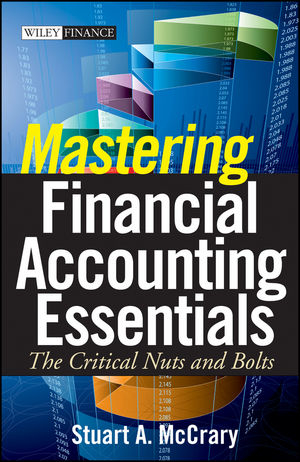
Mastering Financial Accounting Essentials
John Wiley & Sons Inc (Verlag)
978-0-470-39332-1 (ISBN)
An indispensable hands-on guide to financial accounting In light of recent accounting scandals, it is critical that all financial practitioners understand and play by the rules of the accounting field. Starting from the assumption that the reader is not familiar with any accounting jargon, Mastering Financial Accounting Essentials presents material in a way that explains the key features of modern accounting step by step and helps you develop an intuitive understanding of accounting. Each chapter presents important accounting concepts, from inventory valuation methods and the timing of erosion of productive assets to how internal managers calculate ratios and trends to evaluate business efficiency.
For those who need to understand the language and law of this discipline in order to communicate effectively with accountants and clients, Mastering Financial Accounting Essentials will be an indispensable guide.
Stuart A. McCrary is a Principal at Chicago Partners, a division of Navigant Consulting, Inc. He is a trader and portfolio manager who specializes in traditional and alternative investments, quantitative valuation, risk management, and financial software. Prior to joining Chicago Partners, McCrary was president of Frontier Asset Management, managing a market-neural hedge fund. He also held positions with Fenchurch Capital Management as a senior option trader and CS First Boston as vice president and market maker of over-the-counter options. Prior to that, McCrary was a vice president with the Securities Groups and a portfolio manager with Comerica Bank. McCrary has published two previous books with Wiley: How to Creat and Manage a Hedge Fund and Hedge Fund Course.
Preface. Acknowledgments.
CHAPTER 1 Creating Ledger Accounting.
Count Everything.
The Beginnings of Double-Entry Accounting.
Double-Entry Recording of Business Transactions.
Handling Debits and Credits.
Keeping Track of Data.
A Mathematical Description of Double-Entry Conventions.
Handling Income Items.
Determining Profit in the Simple Accounting Model.
Permanent Accounts Overview.
Temporary Accounts Overview.
Conclusion.
Questions.
CHAPTER 2 Accounting Conventions.
Reasons Accountants Develop Conventions.
Accounting Cycle.
Classification.
Comparability.
Conservatism.
Double-Entry.
Full Disclosure.
Focus on Addition.
Generally Accepted Accounting Principles (GAAP).
Going-Concern Value.
Journal Entry.
Matching.
Materiality.
Recognition.
Understandability.
Usefulness.
Valuation.
Verifiability.
Conclusion.
Questions.
CHAPTER 3 Balance Sheet.
Balance Sheet Contains Permanent Accounts.
Time Line of Cash Flows.
Types of Balance Sheet Accounts.
Presenting the Classified Balance Sheet.
Conclusion.
Question.
CHAPTER 4 Adding an Income Statement.
Temporary Accounts.
Using Temporary Accounts.
Types of Transactions Involving Temporary Accounts.
Income Accounts.
Single-Step Income Statement.
Multistep Income Statement.
Conclusion.
Questions.
CHAPTER 5 Timing and Accrual Accounting.
Journaling Accounting Transactions.
Cash Basis Accounting.
Accrual Basis Accounting.
Conclusion.
Questions.
CHAPTER 6 The Statement of Cash Flows.
Importance of Cash.
An Intuitive Way to Track Cash.
Standard Accounting Categories on the Statement of Cash Flows.
Using the Indirect Method to Document Changes in the Cash Position.
Using the Direct Method to Document Changes in the Cash Position.
Producing a Statement of Cash Flows Using the Indirect Method.
Producing a Statement of Cash Flows Using the Direct Method.
Conclusion.
Questions.
CHAPTER 7 Ensuring Integrity.
Internal Controls and Procedures.
Independent Auditing.
The Role of the User of Financial Statements.
Conclusion.
Questions.
CHAPTER 8 Financial Statement Analysis.
Restating Accounting Results.
Ratio Analysis.
Trend Analysis.
Industry Analysis.
Conclusion.
Questions.
Collected Questions.
Answers.
About the Author.
Index.
| Reihe/Serie | Wiley Finance |
|---|---|
| Zusatzinfo | Charts: 7 B&W, 0 Color; Tables: 11 B&W, 0 Color |
| Verlagsort | New York |
| Sprache | englisch |
| Maße | 164 x 232 mm |
| Gewicht | 343 g |
| Themenwelt | Wirtschaft ► Betriebswirtschaft / Management ► Rechnungswesen / Bilanzen |
| ISBN-10 | 0-470-39332-7 / 0470393327 |
| ISBN-13 | 978-0-470-39332-1 / 9780470393321 |
| Zustand | Neuware |
| Informationen gemäß Produktsicherheitsverordnung (GPSR) | |
| Haben Sie eine Frage zum Produkt? |
aus dem Bereich


